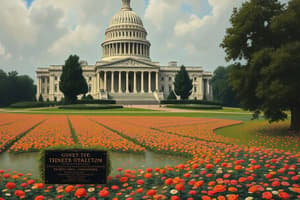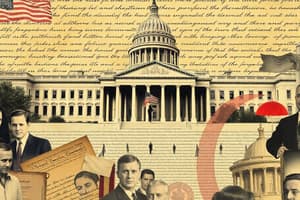Podcast
Questions and Answers
Describe the relationship between the federal government, state governments, and local governments.
Describe the relationship between the federal government, state governments, and local governments.
Foreign policy, especially such issues as declaring war, is primarily conducted at the federal level. The only level of government not mentioned in the Constitution is the local level.
During which of the following periods of time has the United States had a system of dual federalism?
During which of the following periods of time has the United States had a system of dual federalism?
1789 - 1937
How did the Great Depression influence the power of the federal government?
How did the Great Depression influence the power of the federal government?
Federal grants-in-aid became a powerful tool to redirect state governments' policy. The federal government took a more active role than before in providing economic security for Americans.
How is power distributed in the U.S. federal system?
How is power distributed in the U.S. federal system?
States prefer categorical grants to block grants.
States prefer categorical grants to block grants.
Match the type of power to the correct level of government.
Match the type of power to the correct level of government.
States prefer regulated federalism to block grants.
States prefer regulated federalism to block grants.
Match each kind of federalism with an example of it in action.
Match each kind of federalism with an example of it in action.
Why does the federal government impose regulations on money given to state governments?
Why does the federal government impose regulations on money given to state governments?
Welfare is an example of a redistributive policy.
Welfare is an example of a redistributive policy.
Which of the following are potential benefits of federal control?
Which of the following are potential benefits of federal control?
Which of the following are examples of states properly exercising their reserved powers?
Which of the following are examples of states properly exercising their reserved powers?
In the early 1800s, during the era of dual federalism, which statements accurately describe the relationship between the powers of federal and state governments?
In the early 1800s, during the era of dual federalism, which statements accurately describe the relationship between the powers of federal and state governments?
Order these eras of federalism by when they first started, from earliest to most recent.
Order these eras of federalism by when they first started, from earliest to most recent.
Which of the following statements on the balance between state and federal power today are accurate?
Which of the following statements on the balance between state and federal power today are accurate?
This system tends to occur in states with diverse ethnic or language groupings and has a central government that shares power with lower levels of government.
This system tends to occur in states with diverse ethnic or language groupings and has a central government that shares power with lower levels of government.
What is the source of local governments' authority?
What is the source of local governments' authority?
Which political party most favors devolution?
Which political party most favors devolution?
Part of the New York state constitution specifies that the state legislature cannot pass laws that affect New York City without first getting the city's approval. What concept is this an example of?
Part of the New York state constitution specifies that the state legislature cannot pass laws that affect New York City without first getting the city's approval. What concept is this an example of?
Did the following Supreme Court cases grant power to the states or to the federal government?
Did the following Supreme Court cases grant power to the states or to the federal government?
Match the following policies with the level of government that was responsible for that activity under dual federalism.
Match the following policies with the level of government that was responsible for that activity under dual federalism.
Police powers rest with the federal government.
Police powers rest with the federal government.
How does the federal government encourage policy standardization between states?
How does the federal government encourage policy standardization between states?
In McCulloch v. Maryland, the Supreme Court ruled in favor of expanded powers for the federal government.
In McCulloch v. Maryland, the Supreme Court ruled in favor of expanded powers for the federal government.
How does a unitary system differ from the U.S. federal system?
How does a unitary system differ from the U.S. federal system?
The central government in France has considerable control over what the regional governments can and cannot do. What kind of division of power between central and regional governments is this?
The central government in France has considerable control over what the regional governments can and cannot do. What kind of division of power between central and regional governments is this?
In the 1960s, state governments began to lose power relative to the federal government. What was the primary cause of this change?
In the 1960s, state governments began to lose power relative to the federal government. What was the primary cause of this change?
Which of the following is an example of preemption?
Which of the following is an example of preemption?
In 1937, the Supreme Court made a series of significant decisions addressing federalism. How did these decisions influence the course of federalism in the United States?
In 1937, the Supreme Court made a series of significant decisions addressing federalism. How did these decisions influence the course of federalism in the United States?
According to Article VI of the Constitution, when state laws and federal laws are in conflict, the federal law will likely be favored over the state law.
According to Article VI of the Constitution, when state laws and federal laws are in conflict, the federal law will likely be favored over the state law.
This type of grant from the federal government to states and localities comes with a condition that the expenditure be limited to a specific problem.
This type of grant from the federal government to states and localities comes with a condition that the expenditure be limited to a specific problem.
The federal government provides grants to the states to encourage them to use more evidence-based practices in their education curricula.
The federal government provides grants to the states to encourage them to use more evidence-based practices in their education curricula.
The federal government sets a new environmental standard for emissions and states are required to follow it.
The federal government sets a new environmental standard for emissions and states are required to follow it.
A limited national government helps build roads and promote infrastructure, but otherwise most responsibilities are left to the states.
A limited national government helps build roads and promote infrastructure, but otherwise most responsibilities are left to the states.
Flashcards are hidden until you start studying
Study Notes
Federalism in the United States
- The U.S. government comprises three levels: federal, state, and local, where foreign policy declared war is primarily federal; local government lacks mention in the Constitution.
- Dual federalism prevailed from 1789 to 1937, characterized by distinct responsibilities among state and federal governments.
- The Great Depression shifted power more towards the federal government, utilizing grants-in-aid for state policy enforcement and economic security.
Power Distribution
- The U.S. federal system divides powers between national and state governments.
- State powers are reserved, while concurrent powers are shared, and federal powers are expressed and implied.
- States typically favor block grants over categorical grants, contrary to some beliefs regarding funding preferences.
Types of Federalism
- Various forms of federalism include:
- Dual Federalism: Limited interaction between federal and state governments.
- Cooperative Federalism: Collaboration between governments, with federal incentives for state policy alignment.
- Regulated Federalism: Imposition of federal standards that states must adhere to, ensuring policy uniformity.
Constitutional Provisions
- The 10th Amendment is frequently cited in arguments supporting states' rights.
- The Commerce Clause and Necessary and Proper Clause have been vital in expanding federal power since 1937.
- Full faith and credit clause ensures that legal documents (e.g., marriage licenses) are recognized across states.
Supreme Court Influence
- Landmark cases (e.g., McCulloch v. Maryland and Gibbons v. Ogden) have historically amplified federal powers, while cases like United States v. Lopez granted more power to states.
- The balance of power between state and federal authorities is often addressed by the Supreme Court, with ongoing debates over state autonomy versus federal intervention.
Local Governments and Authority
- Local governments derive their authority from state governments.
- Home rule exemplifies local governance autonomy, allowing cities to pass specific laws pending state approval.
Federal Grants and Mandates
- Federal grants can be categorized into:
- Categorical Grants: Specific purpose funding with strict regulations.
- Block Grants: General funding with flexible use.
- Unfunded mandates pose challenges, leading Congress to assess and potentially fund costs exceeding specified limits.
Political Dynamics
- The Republican Party generally supports devolution, advocating for a reduction in federal power and an increase in state control.
- The federal government sometimes overrides state laws to achieve policy standardization, driven by national interests.
Modern Federalism Challenges
- State and federal governments interact continuously, influenced by economic, social, and legal factors.
- Significant Supreme Court decisions since 1937 have reaffirmed the power dynamics shaping contemporary federalism.
Misconceptions
- Police powers are fundamentally a state responsibility, not federal.
- Contrary to some beliefs, states generally prefer flexibility in funding arrangements from the federal government.
Studying That Suits You
Use AI to generate personalized quizzes and flashcards to suit your learning preferences.




